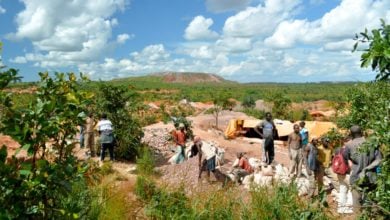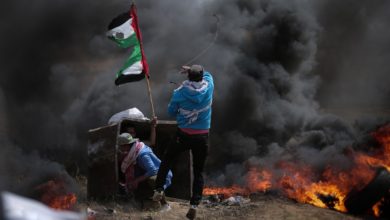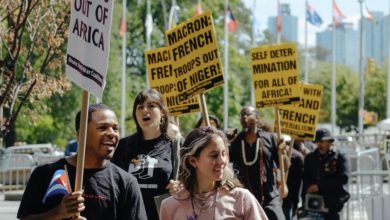Economic news out of South Africa
continues to be grim. Unemployment increased in the third quarter to 24.5 percent, up from 23.6
percent in the second quarter of this year. The tally rises to 34.4 percent when adjusted for
those who have given up looking for work. (Bloomberg News, Oct. 29) President
Jacob Zuma declared on Dec. 3 that more jobs would most likely be lost, saying in part: “Although the economy is beginning to grow again, the crisis
is still with us, especially for the poor and the working poor.” (Reuters, Dec.
3)
 COSATU sticker |
Against
this backdrop, the political contradictions have continued to sharpen. The Zuma
government was elected by placing the conditions of the working class in the
center of its appeal, alluding—mostly in a vague fashion—to a serious attack on
poverty. However, the government has not responded in a substantive way to the
demands raised by the working-class organizations within the Africa National
Congress alliance—the trade union federation Congress Of South African Trade
Unions and the South African Communist Party—or to the demands raised by the
struggles of the workers in the townships.
The
working class, however, has refused to be placated and since the April
elections have engaged in a series of strikes and protests in the townships
over wage issues and the lack of social services. Inside the ruling ANC
alliance, the tensions have also sharpened.
COSATU and
the SACP, far from just echoing support for the struggles of the unions or the
townships, have sought to give a shape to the vague pro-working class promises
put forward in the past ANC election campaign. Their primary focus has been on
gaining structural changes in the government to promote a more centralized
national development policy focused on creating and nurturing industries to
alleviate the chronic joblessness and poverty in South Africa, and providing
improved social services.
While the
government has responded by making minor structural changes, in its major
policies the government has yet to present any long-term jobs plan or
“development” proposals. President Zuma recently proposed a jobs bank using
mostly existing funds in a more “targeted” manner—a weak response to the crisis
of unemployment. Zuma had pledged when elected to create just 500,000 jobs, in a country where 4.19
million people are unemployed (Telegraph, June 3)
ANC right wing expresses alarm
Despite
the relative lack of response from the Zuma government to the militant actions
of the working class and more determined calls for action by alliance partners,
the right wing of the ANC, the pro-capitalist elements, have been in an uproar
about “communist” and “socialist” take-overs of the ANC. Typical are comments
like those of ANC National Executive Committee member Billy Masetlha: “The day the ANC sings to the socialist agenda, it would be
signing its death warrant.” (Sowetan, Oct 12)
Some socialist critics outside the
ANC view any work within the alliance as fruitless. They argue that the lack of
concrete progress in changing the strategic direction of the government
reflects the fact that the ANC cannot be an instrument of economic and social
progress for the working class and peasantry.
How then to explain the outrage of
the right against the pro-working class elements of the alliance? It is obvious
to those who want to continue the path of capitalist investment that has led to
enormous inequalities fear the emergence of a socialist presence in both the
alliance and in broader society challenging the very existence of capitalism.
The rising, if uneven, tide of
resistance among the workers both in a union context and in the townships
raises to an undeniable level the contradictions of capitalism. It reveals a
country of tremendous riches where all but a small few live in abject poverty,
lacking jobs, decent incomes and access to social services such as health care
and water.
The issues under discussion raise
real fears for capitalists in South Africa. Railing
against “communism” and “socialism” are clear signs that capitalists in South
Africa are worried about any institutionalization of increased power of working
people. Even small moves such as naming a COSATU economist as economic
development minister seem to be too much for many ANC leaders.
Tensions
increased during and after a recent December 2009 special conference of the
SACP. ANC NEC members, including ANC Youth League chairman Julius Malema, were
booed by the SACP delegates. SACP members rejected ANCYL proposals on
nationalization as opportunistic; COSATU raised similar criticisms saying the
proposals lacked “substance.”
The
question of “socialization” and “nationalization” reflects on the very nature
of the government, determining if and how the working people will benefit from
and have control over the material resources of their country. Anti-Communist
ANC leaders have also opposed COSATU’s campaign against corruption, which has
highlighted lavish living on the part of alliance leaders and government
ministers.
From the
point of view of the right within the ANC, and the capitalist class in general,
demands to curtail their lifestyle, restrictions on their ability to gain
privileged positions in government enterprises, losing some of their grip in
terms of labor law, and the increased discussion and promotion of socialist and
communist ideas all combine to present a foreboding picture. These forces are
now attempting to go on the offensive against socialist organizations and the
trade unions.
The
struggle between the working classes and capitalists in South Africa is not
proceeding in a linear manner. Working-class people have not hesitated to
confront the ANC government, yet at the same time they also gave the ANC the
vast majority of their votes in the past national election. Not hesitating to
organize outside of alliance structures, large numbers of working people also
look to the organizations that have served them well over time going back to the
struggle against Apartheid.
It is
worth making a general comparison with the Venezuelan revolution, where a
highly contradictory cross-class alliance has been caught up in a socialist
revolution where many questions are yet to be answered. This seems to speak to
the positive role the interventions by the SACP and COSATU can have in
advancing the class struggle in South Africa.
In
Venezuela, however, the presidency and elements of the state are also anchors
of the left wing of the revolutionary process in conjunction with the movements
of the workers and peasants—as opposed to South Africa where the executive is
an unstable ally at best, and where working-class movements exercise little
direct control or overt influence over the institutions of the capitalist
state.
In South
Africa in the coming months, we will undoubtedly see more intense class
struggle, and the dedicated, pro-working class elements inside and outside the
alliance will become clearer as tensions sharpen. While many contradictions and
unanswered questions remain, with the country’s largest trade union federation
and the Communist Party discussing strategies to build socialism, South Africa
will be one of the central battlegrounds of the worldwide struggle against capitalism





